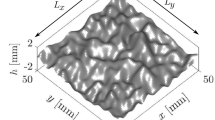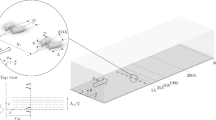Abstract
In this paper, a simplified inviscid boundary condition is applied to solve the problem of Mach waves generated by a roughness element on the wall surface of a supersonic wind tunnel. The geometry of the roughness element is simplified by a parabolic function, to which mathematical formulas are introduced to model the boundary condition. These techniques help simplify the problem and minimize the required computer resources for the simulation performance. Using the direct numerical simulation (DNS) method while employing the above-mentioned techniques, the authors can simulate the generation and the propagation of Mach waves from a roughness element at a Mach number of 2.5. The result shows that a pair of Mach waves are generated at the leading and trailing edges of the roughness element and oscillate with small amplitudes. We also study the effect of the height of the element, the flow speed, the Reynolds number, and the unsteadiness of the flow on the simulation result. The numerical result is compared with published experimental data for the validation.



















Similar content being viewed by others
References
Schneider SP (2001) Effects of high-speed tunnel noise on laminar-turbulent transition. J Spacecr Rocket 38(8):323–333
Schneider SP (2008) Development of hypersonic quiet tunnels. J Spacecr Rocket 45(4):641–664
Chen FJ, Malik MR, Beckwith IE (1989) Boundary-layer transition on a cone and flat plate at Mach 3.5. AIAA J 27:687–693
Cavalieri DA (1995) On the experimental design for instability analysis on a cone at Mach 3.5 and 6.0 using a corona discharge perturbation method. Master’s thesis, Illinois Institute of Technology
Corke TC, Cavalieri DA, Matlis E (2002) Boundary-layer instability on sharp cone at Mach 3.5 with controlled input. AIAA J 40(5):1015–1018
Reda DC (2002) Review and synthesis of roughness-dominated transition correlations for reentry applications. J Spacecr Rockets 39(2):161–167
Berry SA, Horvarth TJ (2007) Discrete roughness transition for hypersonic flight vehicles. AIAA-2007-0307
Schneider SP (2004) Hypersonic laminar-turbulent transition on circular cones and scramjet forebodies. Progr Airspace Sci 40(1/2):1–50
Holloway PF, Sterrett JR (2011) Effect of controlled surface roughness on boundary-layer transition and heat transfer at Mach numbers of 4.8 and 6.0. NASA Technical Note 2054:44
Yermolaev YuG, Yatskih AA, Kosinov AD, Semionov NV, Kolosov GL, Panina AV (2016) Experimental study of the effects of couple weak waves on laminar-turbulent transition on attachment-line of a swept cylinder. In: AIP
Kocharin VL, Kosinov AD, Yatskikh AA, Ermolaev YuG, Semionov NV, Piterimova MV, Shevelkov SG, Minin OP (2019) The impact of weak shock waves on the flow in the boundary layer of a flat plate with a variable sweep angle of the leading edge. Thermophys Aeromech 26:803–809
Ermolaev YuG, Kosinov AD, Kocharin VL, Semenov NV, Yatskikh AA (2019) Experimental Investigation of the weak shock wave influence on the boundary layer of a flat blunt plate at the Mach number 2.5. Fluid Dyn 54:257–263
Vaganov AV, Ermolaev YuG, Kolosov GL, Kosinov AD, Pania AV, Semionov NV, Yatskikh AA (2016) Impact of incident Mach wave on supersonic bourndary layer. Thermophys Aeromech 23(1):43–48
Fasel HF, Konzelmann U (1990) Non-parallel stability of a flat-plate boundary layer using the complete Navier-Stokes equations. J Fluid Mech 221:311–347
Kleiser L, Zang TA (1991) Numerical simulation of transition in wall bounded shear flows. Ann Rev Fluid Mech 23:495–537
Reed HL (1993) Direct numerical simulation of transition: the spatial approach. AGARD Report 793. AGARD-FDP-VKI Special Course
Zhong X, Wang X (2012) Direct numerical simulation on the receptivity, instability, and transition of hypersonic boundary layers. Annu Rev Fluid Mech 44:527–561
Fong KD, Wang X, Zhong X (2013) Stabilization of hypersonic boundary layer waves using 2-D surface roughness. In: 43rd fluid dynamics conference, January, pp 1–20
White FM (1991) Viscous fluid flow. McGraw-Hill Science/Engineering
Loytsyanskiy L (1978) Mechanics of liquid and gas. Nauka, Moscow
Novikov A, Egorov I (2016) Direct numerical simulations of transitional boundary layer over a flat plate in hypersonic free-stream. In: 46th AIAA fluid dynamics conference, Washington, DC, pp AIAA Paper 2016-3952, pp 1–2, 13–17 June 2016
Jiang G-S, Shu C-W (1996) Efficient implementation of weighted ENO schemes. J Comput Phys 1(126):202–228
Novikov A, Egorov I, Fedorov A (2016) Direct numerical simulation of wave packets in hypersonic compression-corner flow. AIAA J 54(7):2034–2050
Anderson JD (2001) Fundamentals of aerodynamics. McGraw-Hill, New York
Acknowledgements
This research is funded by the project titled “The effects of Mach waves on the transition from the laminar to the turbulent states in supersonic flows”, Grant Number QTRU01.01/20-21. The authors would like to thank Prof. A.D. Kosinov and Dr. Y.G. Ermolaev in Khristianovich Institute of Theoretical and Applied Mechanics for the experimental data used in this work and their valuable consultancy.
Author information
Authors and Affiliations
Corresponding author
Ethics declarations
Conflict of interest
The authors declared no potential conflicts of interest with respect to the research, authorship, and publication of this article.
Additional information
Publisher's Note
Springer Nature remains neutral with regard to jurisdictional claims in published maps and institutional affiliations.
Rights and permissions
About this article
Cite this article
Dinh, H.Q., Nguyen, A.T., Egorov, I.V. et al. The Study of Mach Waves Generated by a Roughness Element. Int. J. Aeronaut. Space Sci. 23, 511–520 (2022). https://doi.org/10.1007/s42405-022-00471-6
Received:
Revised:
Accepted:
Published:
Issue Date:
DOI: https://doi.org/10.1007/s42405-022-00471-6




